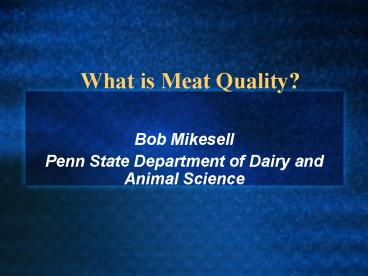What is Meat Quality - PowerPoint PPT Presentation
1 / 44
Title: What is Meat Quality
1
What is Meat Quality?
- Bob Mikesell
- Penn State Department of Dairy and Animal Science
2
Eating Experience
Safety
Meat Yield
Wholesomeness
3
What Do You Think Makes Meat Taste Great?
4
What Can You Do to Make Sure the Meat From Your
Animal Tastes Great?
5
What Makes High Value Meat?
- Quality
- Color
- Texture
- Marbling
- etc.
- Yield
- Muscle
- Fat
Lets look at beef first
6
Beef Yield Grade
- Estimate of amount of meat
- Fat thickness over the ribeye
- kidney, pelvic, and heart fat
- rib-eye area
- hot carcass weight
7
(No Transcript)
8
(No Transcript)
9
Beef Yield Grades
- YG Range 1 (lean, heavily muscled) to 5 (fat,
light muscled). - Higher carcass weight worse YG
- Higher kidney, pelvic and heart fat worse YG.
10
YG 5
YG 3
YG 1
Photos Courtesy of Meat Evaluation Handbook,
available from the American Meat Science
Association (www.meatscience.org)
11
Beef Quality Grades
- Higher grade for more fat flecks in the ribeye
muscle - Also uses age, color, and lean texture to assign
final grades - Beef quality grades refer to how good the cooked
meat will taste
12
USDA Beef Quality Grades
Most Desirable
MARBL ING
- Young Cattle
- USDA Prime
- USDA Choice
- USDA Select
- USDA Standard
- Old Cattle
- USDA Commercial
- USDA Utility
- USDA Cutter
- USDA Canner
Least Desirable
13
Marbling Degree Pictures
Photos Courtesy of Meat Evaluation Handbook,
available from the American Meat Science
Association (www.meatscience.org)
14
USDA Beef Quality Grades - Availability
USDA Prime - 2.0
USDA Choice - 48
USDA Select - 47.4
Source 2000 USDA
15
How do you age a beef carcass?
- You ask the bones
- Thoracic Vertebrae (buttons)
- Lumbar Vertebrae
- Sacral Vertebrae
- Ribs
- Aitch Bone
16
Fat and lean color
Photos Courtesy of Meat Evaluation Handbook,
available from the American Meat Science
Association (www.meatscience.org)
17
Enough about Beef..
18
Lamb Yield Grades
Body wall thickness, measured 5 inches from the
spine between The 12th and 13th ribs
Back Fat, measured at the Center of the rib eye
between The 12th and 13th ribs.
19
- Rib Eye Area (at the 12th rib)
- USDA does not measure muscling to determine YG,
but many carcass evaluation contests do - Normal range 2 in2 to 3 in2
- Usually ribeye area is adjusted for Carcass Wt.
- The grid used has 20 dots per in2
- If possible, both sides are measured to determine
the average ribeye area
20
Lamb Quality Grading
- Quality Grades - predicts eating quality
- Prime
- Choice
- Good - Utility -Cull
- Factors used for Quality Grades
- Quality
- Maturity (age of animal)
- Confirmation
21
Photos Courtesy of Meat Evaluation Handbook,
available from the American Meat Science
Association (www.meatscience.org)
22
Quality factors
- Fat streaking in the flank
- (primary and secondary)
- Feathering
- Streaks of fat between the ribs
- Fullness and firmness of the flank
- Marbling intra-muscular fat
- All indicate the lamb has been fed a high energy
diet and should taste good.
23
Photos Courtesy of Meat Evaluation Handbook,
available from the American Meat Science
Association (www.meatscience.org)
24
Choice Flank Streaking
25
Prime Flank Streaking
26
Marbling intra-muscular fat
27
Lamb Maturity
Break Joint (left) Breaks at the break
joint Evidenced by rough, reddish area where
broken. Spool Joint (right) Growth plate has
fused and will not break appears much smoother
and whiter. These usually fuse at about 12
months
28
Confirmation
Conformation is simply the shape or formof the
carcass and indicates a high energy diet which
makes the meat taste better. The quality grade
is adjusted for Conformation to determine the
final Quality Grade
Avg Avg Avg Prime Choice Good
29
And then there are pigs
30
Pork Carcass Yield
- Largely based on 10th rib fat depth
- Loineye size important too.
- Is there such a thing as too lean?
31
(No Transcript)
32
What is Pork Quality?
- Pork quality is the things that make the pork
taste good. - Color
- Marbling
- Water-Binding Capacity
- Firmness
33
Photos Courtesy of Meat Evaluation Handbook,
available from the American Meat Science
Association (www.meatscience.org)
34
PSE
RFN
DFD
Color Drip Loss Relationship
35
Firmness
- Evaluate on a cut surface (loineye or ham)
- Firm pork retains shape
- Soft pork deforms easily and sags
- Better eating quality with firmer pork
36
Handling Effects on Quality
- Poor Pre-Slaughter Handling
PSE
Bruising
37
(No Transcript)
38
Examples of Quality Problems. Beef
39
2 mls 7-Way at Branding Time (50 Days of Age)
NCA/BQA - 1995
40
5 mls 7-Way at Branding Time (50 Days of Age)
NCA/BQA - 1995
41
Vitamin A D
Injected at 50 Days of Age
NCA/BQA - 1995
42
(No Transcript)
43
These are NOT Pancakes
44
Its Your Turn.
- Measure fat depth at correct location
- Lay grid on surface
- Count dots
- Divide number of dots by 20 to get square inches.































